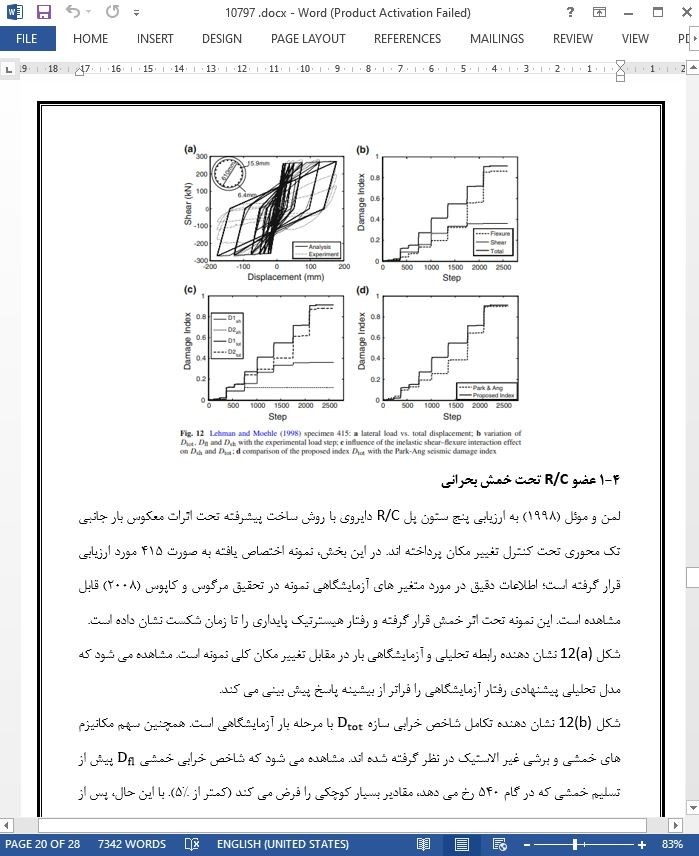
تحلیل خرابی لرزه ای شامل اندرکنش برشی - خمشی غیرالاستیک
چکیده
این مقاله به بررسی تحلیل خرابی لرزه ای اعضای بتنی مسلح (R/C) با در نظر گرفتن اندرکنش برشی-خمشی در محدوده غیر الاستیک می پردازد. در ابتدا جزء محدودی از تیر-ستون جهت تحلیل لرزه ای سازه های R/C به طور مختصر مورد اشاره قرار می گیرد. مدل تحلیلی شامل دو زیرجزء با انعطاف پذیری گسترده است که در طی تحلیل جهت شبیه سازی پاسخ برشی و خمشی غیر الاستیک عمل می کنند. جزء محدود اثر کاهش مقاومت برشی همراه با تقاضای انحنای غیر الاستیک و همچنین ترکیب بین تغییر شکل های برشی و خمشی غیر الاستیک پس از تسلیم خمشی را در نظر می گیرد. بر اساس این مدل، یک شاخص خرابی لرزه ای با در نظر گرفتن تغییر شکل های برشی و خمشی و همچنین اندرکنش آنها پیشنهاد می شود. جزء محدود و شاخص خرابی لرزه ای به منظور تحلیل پاسخ ستون های R/C ارزیابی شده تحت بارگذاری سیکلی و در حال خرابی در حالت برشی یا خمشی مورد استفاده قرار می گیرند. نشان داده می شود که مدل تحلیلی و شاخص خرابی می توانند پاسخ هیسترتیک ستون های R/C با انواع مختلف شکست را به طور مناسب پیش بینی و بیان نمایند.
1- مقدمه
اکثر سازه های R/C موجود بر اساس آیین نامه های لرزه ای جدید طراحی نشده اند. این سازه ها به احتمال فراوان شکست های ترد را با پیامد های جبران ناپذیر در طی وقوع یک رخداد لرزه ای بزرگ تجربه می کنند. از این رو، باید ارزیابی لرزه ای کامل و قابل اطمینان از این سازه ها در مورد اثرات برشی غیر الاستیک مورد توجه قرار گیرند. اولین مرحله جهت انجام تحلیل خرابی لرزه ای واقعی، ارائه یک مدل تحلیلی است که قادر به پیش بینی رفتار سازه ای غیر خطی در طی یک رخداد لرزه ای به صورت دقیق است. مدل سازی صریح برش غیر الاستیک می تواند نقش اصلی را در این خصوص به ویژه در حالت سازه های قابی طراحی شده تحت اثر بار ثقلی (GLD) ایفا کند.
5- نتیجه گیری
یک مدل انعطاف پذیر گسترده خمشی و برشی با در نظر گرفتن اندرکنش خمشی- برشی جهت ارزیابی لرزه ای سازه های R/C ارائه شده است. این مدل قادر به ثبت کاهش مقاومت برشی و همچنین افزایش تغییر شکل های برشی غیر الاستیک و در پی آن تسلیم خمشی است. بر اساس این مدل جزء محدود، یک شاخص خرابی ترکیبی برای تحلیل خرابی لرزه ای سازه های R/C پیشنهاد می شود. این شاخص خرابی در برگیرنده هر دو تغییر شکل خمشی و برشی غیر الاستیک و همچنین اندرکنش آنها است.
Abstract
The paper focusses on seismic damage analysis of reinforced concrete (R/C) members, accounting for shear–flexure interaction in the inelastic range. A finite element of the beam-column type recently proposed by the writers for the seismic analysis of R/C structures is first briefly described. The analytical model consists of two distributed flexibility sub-elements which interact throughout the analysis to simulate inelastic flexural and shear response. The finite element accounts for shear strength degradation with inelastic curvature demand, as well as coupling between inelastic flexural and shear deformations after flexural yielding. Based on this model, a seismic damage index is proposed taking into account both inelastic flexural and shear deformations, as well as their interaction. The finite element and the seismic damage index are used to analyse the response of R/C columns tested under cyclic loading and failing either in shear or in flexure. It is shown that the analytical model and damage index can predict and describe well the hysteretic response of R/C columns with different types of failure.
1 Introduction
The vast majority of existing R/C structures has not been designed according to modern seismic codes. These structures are very likely to experience brittle types of shear failure with grave consequences during a major seismic event. Therefore, a complete and reliable seismic assessment of these structures should account for inelastic shear effects. The first step to perform a realistic seismic damage analysis is to develop an analytical model which is able to predict accurately nonlinear structural behaviour during a seismic event. Explicit modelling of inelastic shear may play a key role in this respect, especially in the case of gravity load designed (GLD) frame structures.
5 Conclusions
A distributed shear and flexural flexibility model with shear–flexure interaction for seismic assessment of R/C structures has been developed. The model is able of capturing shear strength degradation as well as increase of inelastic shear deformations subsequent to flexural yielding. Based on this finite element model a combined damage index is proposed for the seismic damage analysis of R/C structures. This damage index accounts for both inelastic flexural and shear deformations as well as their interaction.

چکیده
1- مقدمه
2- جزء محدود با اندرکنش برشی- خمشی
2-1 زیر جزء خمشی
2-2 زیر جزء برشی
3- شاخص خرابی لرزه ای
4- ارتباط و همبستگی با نتایج آزمایشگاهی
4-1 عضو R/C تحت خمش بحرانی
4-2 عضو بتنی مسلح تحت خمش- برش بحرانی
4-3 عضو R/C تحت برش بحرانی
5- نتیجه گیری
Abstract
1 Introduction
2 Finite element with shear–flexure interaction
2.1 Flexural sub-element
2.2 Shear sub-element
3 Seismic damage index
4 Correlation with experimental results
4.1 Flexure-critical R/C member
4.2 Flexure-shear critical R/C member
4.3 Shear-critical R/C member
5 Conclusions
- ترجمه فارسی مقاله با فرمت ورد (word) با قابلیت ویرایش، بدون آرم سایت ای ترجمه
- ترجمه فارسی مقاله با فرمت pdf، بدون آرم سایت ای ترجمه
